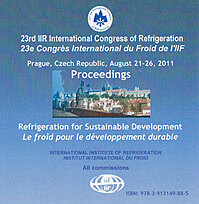
Résumé
As the global warming has been accelerated, many countries make efforts to expand the use of renewable energy and improve energy efficiency. The energy consumption in building takes over around 30~40% in many countries. The energy reduction of building is very urgent for the global energy efficiency. As these efforts, "low energy houses", "passive houses", "zero-energy houses", and "energy-plus houses" have been researched and constructed in the field of architecture. The Korean government has also planned to build passive houses in 2017, zero energy houses in 2025 for all new residences.Even there is no standard for Passive House in Korea though, the criteria of insulation are weaker than the Passive Houses.On this study, domestic and Passive House regulation were compared. Base on the comparison, the analysis of the thermal loads was performed by VE (Virtual Environment) simulation tool through application of Passive House regulation into Korean standard model. The purpose of this paper is to develop the insulation standard in Korea to achieve the goals of passive house as adata base.
Documents disponibles
Format PDF
Pages : 5 p.
Disponible
Prix public
20 €
Prix membre*
Gratuit
* meilleur tarif applicable selon le type d'adhésion (voir le détail des avantages des adhésions individuelles et collectives)
Détails
- Titre original : A study on the development of passive house insulation standard in Korea.
- Identifiant de la fiche : 30002799
- Langues : Anglais
- Sujet : Réglementation, Environnement
- Source : Proceedings of the 23rd IIR International Congress of Refrigeration: Prague, Czech Republic, August 21-26, 2011. Overarching theme: Refrigeration for Sustainable Development.
- Date d'édition : 21/08/2011
Liens
Voir d'autres communications du même compte rendu (569)
Voir le compte rendu de la conférence
-
Natural ventilation performance in urban buildi...
- Auteurs : JUNG S., JIN J., SONG D.
- Date : 16/06/2013
- Langues : Anglais
- Source : Clima 2013. 11th REHVA World Congress and 8th International Conference on Indoor Air Quality, Ventilation and Energy Conservation in Buildings.
- Formats : PDF
Voir la fiche
-
Design for a new type of environmentally friend...
- Auteurs : UNNO K., ENDO E., KOBAYASHI Y., et al.
- Date : 16/06/2013
- Langues : Anglais
- Source : Clima 2013. 11th REHVA World Congress and 8th International Conference on Indoor Air Quality, Ventilation and Energy Conservation in Buildings.
- Formats : PDF
Voir la fiche
-
Post occupants’ evaluation on green building te...
- Auteurs : YANG S. W., YOO H. J., CHOI S. K., et al.
- Date : 16/06/2013
- Langues : Anglais
- Source : Clima 2013. 11th REHVA World Congress and 8th International Conference on Indoor Air Quality, Ventilation and Energy Conservation in Buildings.
- Formats : PDF
Voir la fiche
-
A field study on energy consumption and buildin...
- Auteurs : SEO B. D., LEE J. E., CUI M., et al.
- Date : 16/06/2013
- Langues : Anglais
- Source : Clima 2013. 11th REHVA World Congress and 8th International Conference on Indoor Air Quality, Ventilation and Energy Conservation in Buildings.
- Formats : PDF
Voir la fiche
-
Comparison of energy performance requirements i...
- Auteurs : KURNITSKI J., GRÖNLUND V., REINIKAINEN E.
- Date : 16/06/2013
- Langues : Anglais
- Source : Clima 2013. 11th REHVA World Congress and 8th International Conference on Indoor Air Quality, Ventilation and Energy Conservation in Buildings.
- Formats : PDF
Voir la fiche
